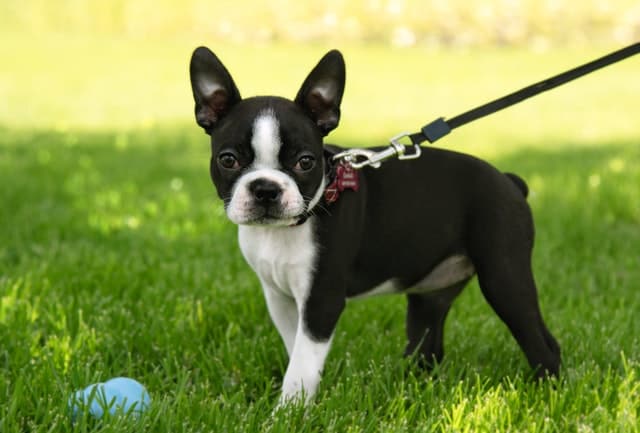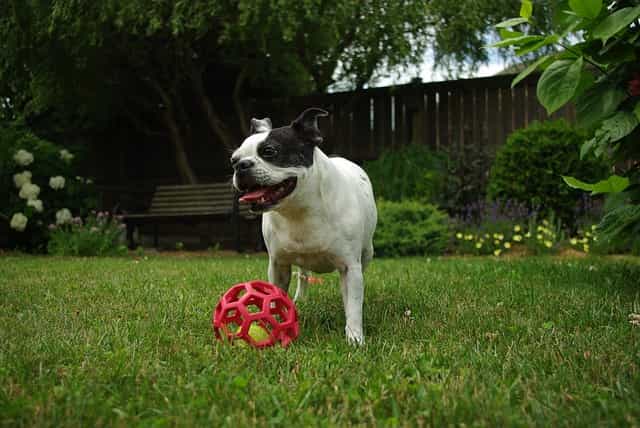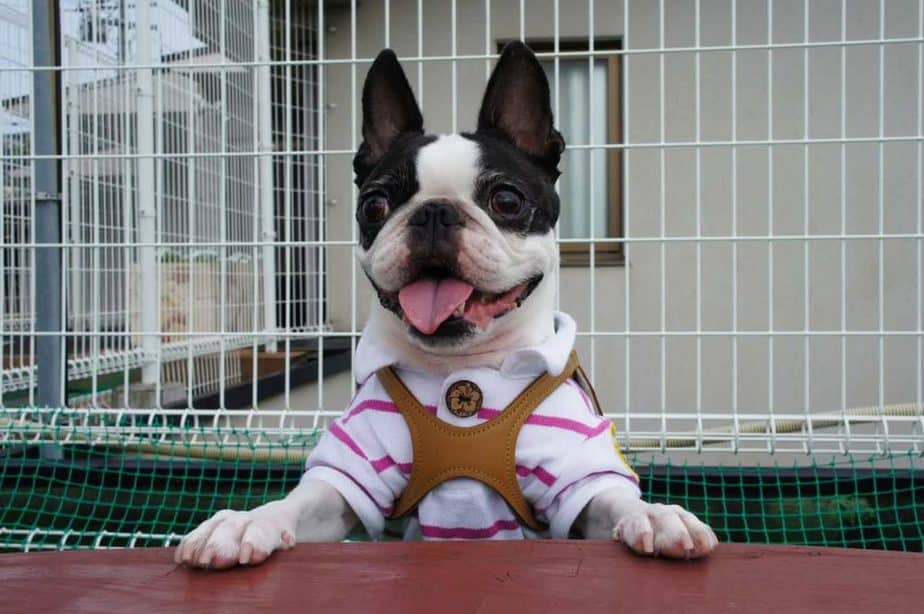The Boston terrier AKA the American-gentleman a nickname earned by his impeccable manners and tuxedo-like coat, is one of the easiest dog breeds to deal with, crate training a Boston terrier is easy fun and enjoyable.
Bringing home a Boston terrier is sure going to make it in the top 3 best choices of your life, they are the best companions especially for inexperienced dog owners.
So how can you crate train a Boston terrier?
You simply need to make the crate great, so that your dog feels safe and enjoys being in his crate without you having to force him into it. Everything serving this purpose could be considered crate training, Boston terriers are very outgoing dogs that love to please and easy to get excited so the process is fairly easy.
And that’s what we are going to see in this article along with some of the most common questions related to crate training a Boston terrier puppy.
However, before you start, like any other process you need to be ready and prepare the necessary tools for the task ahead of you.
So what do we need for Boston terrier crate training?
What you need for crate training a Boston terrier

The crate training process is always the same in its guidelines and steps but with a few tweaks depending on every breed’s personality traits.
You need to understand that making the crate the best possible place for your dog is the main idea behind crate training.
So, anything that will enable you to achieve this goal and make the crate great is ok for you to use, treats, toys, food, verbal praise games, and obviously a crate.
What size crate does a Boston Terrier need?
When it comes to crate training in most cases I recommend using the wire crate especially one with double doors and a divider.
The wire crate helps a lot with the crate training process especially at the early phase of exploring the crate.
The dog has an open view and has two doors so he doesn’t feel trapped, which makes him more willing to get into the crate without objections.
The divider is another great feature since the crate needs to be only a few inches larger than your dog, so using the divider helps you adjust the size of the crate as the dog grows without having to change crates every couple of months.
The crate I recommend is The Midwest double door wire crate( click here to check the current price on Amazon).
The best size crate for a Boston terrier is 25L x 18.75W x 20.5 inches. The crate has to provide the puppy enough room to turn around stand up and lay down and that’s it. If the crate is too big the puppy will probably make a corner as his potty corner and use the rest to lay down.
That’s why using a divider when the puppy is too young for the crate is the smart move.
What chew toy is good for a Boston terrier?
Chew toys are another great tool for crate training a Boston terrier, these little cute guys love to play and chew on stuff and you want to use that for training.
Your dog can have access to chew toys at all times even in the crate, and they do a great job in keeping the puppy distracted for a while.
The one I recommend is the Kong (click here to check the current price on Amazon) it’s a great chew toy and the hollow part of it can be filled with food or treats to make a great food puzzle that will keep your dog in the crate for hours.
There are plenty of recipes on the internet to fill the Kong and it’s easy to make you can check out this article from the kong company blog.
The best training treats for a Boston terrier
The Boston terriers love treats and would cooperate for more, that’s what makes them easier to train than most dogs.
Boston terriers are sensitive when it comes to food so choosing a safe good brand is very important. They also tend to get obese easily so you have to monitor your dog’s daily calorie intake.
Using too many treats or ones that are too high on calories could lead to obesity you can read this study about the relationship between feeding patterns and obesity in dogs.
Make sure you’re not using too many treats to avoid health issues and to prevent the dog from being too focused on the treats and then when you stop rewarding with them he no longer performs as well as he did with the treats. You can read this article about training treats and how to use them for more details on the matter.
Crate training a Boston terrier in 5 easy steps

Crate training a Boston terrier is fairly easy even for new dog owners; what makes it so easy is the fact that the Boston terrier is a dog that loves to please and easy to motivate.
Of course, the crate training steps are almost the same for all dogs with the ultimate goal, making the crate great.
Now that you have the proper crate a chew toy and some training treats, you can start crate training your beloved Boston terrier and here are the steps to follow:
Step 1: Introducing your Boston terrier to his crate
Introducing your puppy to his crate is the first and most important step, the first impression is very important.
If your dog is properly introduced to his crate and he has the time to explore it he is less likely to show objections to the crate.
Never introduce your dog to something when it’s time to do it; meaning you can’t just take your puppy and lock him up in a crate he’s never been into and expect him to feel comfortable and turn it into a den.
The best thing to start with is to take the puppy with the leash and take him around the crate and just let him explore it and sniff around.
It would be best if you secure the doors of the crate to avoid any potential incidents that may freak the puppy out.
Placing the crate in a good spot or the puppy’s favorite spot would be very helpful.
Don’t force the dog into the crate make it natural just a few minutes then move on to something else and go back again.
Once your dog is comfortable around the crate and showing some interest in getting into it you can move onto the next step and help him explore the crate.
Step 2: Helping your Boston terrier explore the crate
The wire crate makes this phase much easier, the dog has plenty of open space and a good view so he doesn’t feel trapped. the two doors feature also helps the dog get in and out of the crate easily.
You can start by using training treats toss a few in the crate to lure the puppy inside. once inside reward and praise your dog, and try to use rubs and verbal praise more than treats to avoid overusing them.
Keep doing the same thing lure the puppy inside and once in the crate praise and reward. Your dog is smart enough to understand that being in the crate gets him treats and rewards so after a while he’ll offer to get in the crate on his own to get the treats.
keep repeating the same process for a while but praise more and give less treats for better performance so the dog has to work more to get a treat.
Step 3: Making the crate great
The treats make a great job luring the puppy in the crate however, you need more to make the puppy associate great feelings with the crate.
You can start by using food and start serving the dog his meals inside the crate.
Feeding time is a happy time for all dogs so you definitely want to associate that with the crate.
Dogs evaluate places based on the experiences they had in those places, so you want to make the crate a happy place.
You can use the feeding time to close the crate’s door gently and see how it goes if the puppy is focused on his meal then just keep it closed and open it once he finishes his meal.
Crate training a Boston terrier can’t be done without exercising before going in the crate, they need to be low on energy before they go in there so they can relax.
Take your dog on walks or play sessions just before his crate bedtime and toss in the Kong to keep him distracted in there.
Step 4: Spending time in the crate closed
Slowly increase the time your dog spends in the crate after his meals while you sit next to the crate praising and playing with your Boston terrier.
The Kong does a great job keeping the dog distracted inside the crate even if closed.
I personally prefer to secure the kong to the crate wires to prevent my dogs from grabbing it and going out.
Don’t overuse treats when filling the kong you can also use the dog’s main food to fill it to avoid any potential issues.
gradually start moving around the room instead of just sitting next to the crate but stay where the dog can see you.
When you see progress and the puppy is doing fine you can leave the room every few minutes and just pass by say hello the go back again.
When your dog is spending more than 30 minutes alone in the crate then you’ve almost finished crate training your Boston terrier.
The next and final step would be to leave the Boston terrier in the crate alone while you’re not home.
Step 5: Home alone
Of course in the first couple of times you leave the puppy home alone you need to make it quick, 30 minutes max until the puppy is fine and showing no objections.
The best thing you can do at this stage is to avoid making a scene when leaving and coming back home.
If you say goodbye to the dog then leave he will associate the crate with being left alone and that doesn’t help. The same thing when you come home; you need to stop interacting with your dog at least five minutes before leaving and after coming home.
You also want to place the puppy in his crate at least 15 minutes before you leave for the same reasons so he doesn’t associate it with being left alone.
These little details make all the difference and will enable you to crate train your Boston terrier faster and better.
Boston terrier crate training at night
Crate training a Boston terrier at night is relatively easy if you take the right measures.
So how do you crate train a Boston terrier at night?
- Exercise your puppy before going into the crate to reduce energy and increase fatigue and the need to sleep.
- Don’t let your puppy sleep too much during the day puppies sleep up to 18 hours a day and adults around 12 hours and you want active ours to be during the day.
- Take your puppy for a potty break just before bedtime to reduce the number of times he wakes up during the night for his little business.
- Stop watering your puppy 2 hours before bedtime, Boston terriers have small bladders and will not hold it through the night.
- Place the crate close to your bed preferably in your room to comfort the puppy if he wakes up.
- Reduce outside distractions in the spot you place the crate or get a crate cover if there is much movement going on in the room.
- When the puppy wakes up for a potty break keep it all about pooping don’t interact much.
If you follow these simple steps you’ll be fine crate training a Boston terrier at night.
How often do Boston terriers poop?
Boston terriers poop after every meal so as they get older their need to poop will decrease since the daily meals also decrease.
That is why you need to make sure he had his final meal of the day before bedtime to give him time to do his business and avoid waking up an hour after you’ve put him to sleep.
The older the puppy gets the less he needs to wake up during the night for potty breaks.
Boston terrier puppy pooping in crate
Sometimes this it happens that your puppy pees or poops in the crate, especially during the night.
However, dogs are fairly clean animals and will not poop where they sleep unless they have no choice. So generally your puppy will let you know if he has to go for a break.
There are a couple of potential issues that could happen:
The first is your dog pooping in the crate then he actually continues to do it in the same spot since dogs mainly go to the same spot for their potty breaks. if this happens you need to clean the crate and make sure the dog poops elsewhere for a couple a days before he gets back in.
The second is when you get a crate that is too large for the puppy then he’ll probably make a potty corner within the crate and that’s why I recommended a wire crate with a divider so you can adjust the size of the crate as the puppy grows.
Are Boston Terriers easy to train?

According to the AKC Boston, terriers are among the easiest breeds to train mainly for their eager-to-please attitude and fun and outgoing temperament.
This I’ve experienced also when crate training a Boston terrier of mine, it was a fun and very enjoyable process.
They love to play and fast learners so yes Boston terriers are easy to train.
Are Boston terriers easy to potty train?
As I’ve just said Boston terriers are easy to train in general and crate training just makes it even easier to potty train them.
Crate training is one of the best ways to potty train and housebreak a new puppy by offering a safe place and a daily organized schedule.
The faster you finish crate training your Boston terrier the easier it would be to potty train him.
Can Boston terriers be left alone?
All dogs can be left alone for a while if trained well, they spend a lot of their time inactive anyway, so learning to use that time correctly and helping your dog relax is the best thing you can do.
how long can Boston terriers be left alone
Alone Time: Boston Terriers are devoted companions that prefer company, but they can be left home alone for four to eight hours if a safe space—such as a dogproof area or a crate—is provided.
Orvis
Crate training a Boston terrier will sure increase his tolerance to being left alone and allow you to go ahead with your day knowing that your companion is safe in his crate back home.
You should note that the time the dog can spend alone in a crate increases as he grows so the four to eight hours safe space is for adult Boston terriers, and puppies can’t handle more than two hours of crate training at a time.
Can Boston terriers be left alone for 8 hours?
Crate training a Boston terrier while working a full-time job can be challenging. Leaving the dog in the crate for more than eight hours is not advised and could result in boredom and aggression.
Coming home for lunch
Hiring a dog walker
Exchange dog sitters
Using a playpen
Playpens do a great job at keeping the dog safe, confined, and at the same provide plenty of open space for him to play around.
I recommend the Midwest playpen(click here to check the current price on Amazon) because it can be used indoors and the great thing about it is that it can be attached to the wire crate forming a nice open space for your dog to play around and when he feels like it, he can get into his crate to relax so it doesn’t contradict your crate training efforts.
Boston terrier crate training problems
When crate training any dog there some potential issues you could encounter and Boston terriers are no exception. So here is a small list and how to deal with each issue.
- The puppy cries in the crate at night: all you have to do is ignore it and never let your dog out of the crate while crying so he doesn’t associate getting out of the crate with crying and keeps using it every time he ants out. if it goes on for a long time make sure you calm the dog before letting him out.
- The puppy gets bored in the crate and wants out: using toys especially the kong will keep your Boston terrier distracted in his crate for a while, you can also hide treats in the crate to keep him always interested. However, exercising before the crate time always helps reduce objections.
- The puppy pees in the crate: Make sure the crate is not too big for the puppy, do not punish the puppy it only makes it worst and just clean the crate keep it away for a couple of days then start over.






